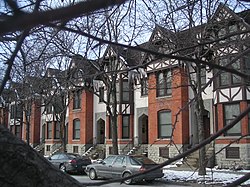Hawley–Green Historic District
This article needs additional citations for verification. (February 2018) |
Hawley–Green Street Historic District | |
 Rowhouses along Hawley Ave. in the Hawley–Green Neighborhood | |
| Location | Wayne, Lodi, Hawley, & N McBride Sts., Syracuse, New York |
|---|---|
| Coordinates | 43°3′15″N 76°8′28″W / 43.05417°N 76.14111°W |
| Built | 1840 |
| Architect | Multiple |
| Architectural style | Stick/Eastlake, Italianate, Queen Anne |
| NRHP reference No. | 79001613[1] (original) BC100002464 (increase) |
| Significant dates | |
| Added to NRHP | May 2, 1979 |
| Boundary increase | May 18, 2018 |
The Hawley–Green Historical District is in the Near Northeast neighborhood of Syracuse, New York, United States. The name comes from the district's two principal streets, Hawley Avenue and Green Street. As Hawley–Green Street Historic District, the district was listed on the National Register of Historic Places in 1979.[1] In 2018 its boundaries were increased to include a number of adjacent streets with similarly styled buildings.[2]
History
[edit]Tucked away in a triangle that some refer to as the "LBJ" triangle, since its borders consist of Lodi Street, Burnet Avenue, and James Street, the major artery of Syracuse's northeastern neighborhoods, Hawley–Green was at first home to carpenters, wagon makers, silversmiths, painters, and musicians. Its original housing stock consisted of splendid Greek Revival, Gothic Revival, and Italianate-style structures, some of which still line its charming streets. By the late nineteenth century the neighborhood had attracted more upperclass types who replaced many of the original structures with Second Empire, Queen Anne, and the Stick Style homes. The arrival of the streetcar helped fuel this upscale transition. These newer residents were doctors, lawyers, dentists, politicians, and clergy.[3]
As of 2014[update], a neighborhood on the upswing,[peacock prose] many of the homes have been restored, the larger ones converted into multi-unit apartment houses, the smaller ones home to a growing artistic community. The area has become famous for its painted ladies, Victorian homes repainted in pastel colors. In 1979 the district was placed on the National Register of Historic Places. The district has been home to the Syracuse Cultural Workers since 2002 and ArtRage Gallery since 2008.
An LGBT-friendly neighborhood
[edit]About forty of the residents of the neighborhood are members of the Hawley–Green LGBT (Lesbian, Gay, Bisexual, or Transgender) Neighbors. This neighborhood group promotes the neighborhood as LGBT-friendly.[citation needed]
References
[edit]- ^ a b "National Register Information System". National Register of Historic Places. National Park Service. April 15, 2008.
- ^ "National Register of Historic Places weekly listings for May 18, 2018". U.S. National Park Service. May 18, 2018. Retrieved May 21, 2018.
- ^ Miller, Ellen (December 20, 1978). "National Register of Historic Places Inventory/Nomination: Hawley–Green Street Historic District". Retrieved May 1, 2009.and Accompanying 28 photos, exterior, from 1978 Archived December 10, 2011, at the Wayback Machine
External links
[edit]- Queen Anne architecture in New York (state)
- Italianate architecture in New York (state)
- Neighborhoods in Syracuse, New York
- Gay villages in New York (state)
- Historic districts in Onondaga County, New York
- Historic districts on the National Register of Historic Places in New York (state)
- National Register of Historic Places in Syracuse, New York





